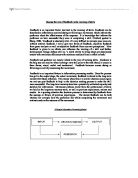In the cognitive stage of learning there are four main points of coaching; instruction, demonstrating, applying and confirming. The coach would start with telling the learner what to do but with as little information as possible so that not to flood the learner with too much information and they cannot remember it.
The second part is demonstrating, this includes the coach showing the pupil how to do the task and so that the pupil can make a clear model of the skill in their memory. This needs to be carefully planned though so that the coach shows exactly what the learner should be trying to do, it would be an opposite affect if the coach did a bad demonstration which would hinder the learners progress at this stage as the wrong information would have been passed along.
“I hear and I forget
I see and I remember
I do and I Understand”
The next point is for the learner to apply what they have already learnt to practicing the skill. Above you will see a proverb which explains why this stage is very important, the learner will always learn more when they are interested or having fun. The coaches’ role is to structure this practice effectively and by appropriate guidance to help learners to apply what they have learned from the instruction and demonstration to the activity itself.
The last major point in the cognitive stage of learning is the feedback the coach gives (confirming). This could be seen as the most important part, it both helps the coach understand what has been learned but to also encourage the leaner to be self-evaluative and reinforces learning plus boosts the moral of the learner.
The coach would use verbal guidance throughout this stage but with the learner being a beginner it may be more appropriate to express the cues in ways that may not be 100% accurate, but convey the feeling of movement to the learner. E.g. ‘Stretch you toes to the ceiling’ or ‘crocodile, monkey, mouse’ (the arm movement in breast stroke).
The next stage of learning (the associative phase) the coach would have to change how they encounter the problem of teaching the learner the correct amount of information.
Sharp (1992) differentiates between ‘practice’ (without guidance) and ‘training’ (practice with guidance).
The learner would need to practice on there own without guidance at some point but long periods could prove demotivating. It could also allow the development of errors without techniques/skills learnt that take a lot of removing which could waste up to 6 month.
The coach would have to give guidance because of this fact to prevent the learner deteriorating there skill.
Manual or mechanical guidance should be used in this stage; this involves the coach using physical contact with the learner, for example a coach supporting a gymnast. It allows the learner to discover the timing and spatial aspects of the movement but does not help them acquire knowledge of the forces that act on the body or the movement cues. The aim is to reduce error and fear, these could both hinder the learner’s progression as the learner would not want to get it wrong over and over again or would be frightened to do a specific technique because it would have the risk of injury if not performed correctly.
Visual aids would be very successful at this stage also, the learner would be able to see how there skills link together and hopefully notice what they are doing wrong so that they can correct it whilst doing he task. Another use for this visual aid would be moral boosting for the learner as they would be able to see how they had progressed from the cognitive stage to the associative stage.
The coach would use verbal guidance throughout this stage, the now advanced learner would be given cues that are detailed and technical, usually to do with specific movements in a skill, for example, in long jump the coach could comment on how the athlete would improve there arm movement in the flight of the jump to give maximum height and power.
The final stage of learning is the autonomous phase. At this phase the coach changes from giving information to the learner and instead concentrates on keeping the athletes moral high and works on the flowing of movements through the task.
The coach would use visual aids to show the learner how they move so that they can see how they can improve there movements, using visual aids in this way would also help the athlete to set new targets which is very important at an elite status so that the learner just don’t give up. A good example of this was Colin Jackson; he was and still is the record holder of the indoor 60m hurdles and outdoor 110m hurdles. In 2002 he set himself a target of winning three international honours – the first he captured in Vienna in March winning the European Indoor 60m hurdles title for the fourth time. In summer 2002 he missed out on adding a third Gold medal to his Commonwealth tally after hitting the first hurdle but recovered amazingly to claim his second Silver medal in this event. The European Championships in Munich saw Colin bring home the Gold medal for the 4th time. Colin Jackson is now retired but setting targets with his coaches helped him mentally and made him able to strive for an objective than he could possible have done.
Through all of these stages the coach is helping the athlete to progress, each stage having its very own way of teaching. Each stage is different to the other but has the same effect on the athlete, to enhance there progression of learning.
Word Count - 1233







